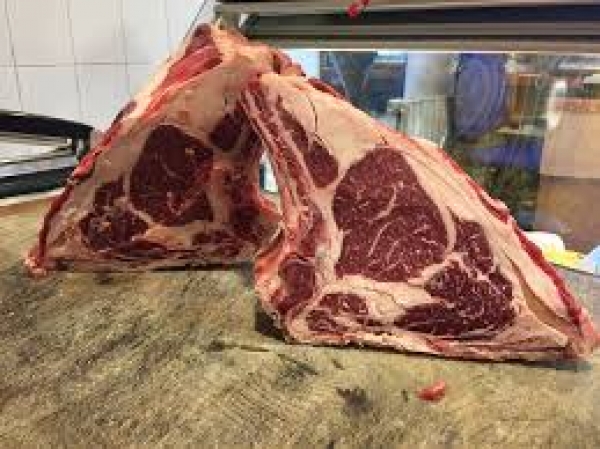Tuscan Cuisine is one of the oldest among Italian regional cuisines. Even today, many of the typical dishes are still prepared according to their original recipe. Like almost all Italian traditional cuisines, the Tuscan one is characterized by simple preparations with easy-to-find country ingredients, but here dishes always have strong and decisive flavors. I love Tuscan cuisine because it is straight, truthful, trattoria-style; the dishes are tasty and salutary, nutritious, refined without becoming pretentious.
Tuscan cuisine as we know it originated from the chefs following Caterina de 'Medici. As she married the son of Francis I, the future King Henry II, in 1533 these chefs brought to France the taste for elaborate dishes and laid the foundations for the most sophisticated Western cuisine. But the customs of the palaces did not extend to the squares, which continued to cultivate a gastronomic tradition of great sobriety. The cornerstones of the region's cuisine are beef, sheep, pigs and even game and poultry - cooked on a skewer, grilled, boiled or baked in the oven.
So let me introduce you to the dishes that make it one of the best regional cuisine in Italy, perhaps the most famous, but also the most copied by chefs and housewives around the country. But first, two delicacies without which Tuscan cuisine would not be so extraordinary: oil and bread.
PANE E OLIO
The "sciocco" (silly) or "sciapo" bread, that is without salt, is the typical bread of Tuscany, and also my favorite Italian bread. The tradition of eating bread without adding salt to the dough, as opposed to the salty bread of other regions, dates back to very ancient times. Some say it depends on the historical clashes between Florentines and Pisa (there is always a story about a clash in past times between Florentines and Pisians, with the Senese variant, in other words Florentines always quarrel with everybody), others on the high cost of salt in Florence. Anyway, the typical Tuscan bread is the ideal compensation for the strong and savory tastes of Tuscan cuisine, and is perfect in soups such as Ribollita or in summer dishes such as Pappa al Pomodoro.
The other main character of Tuscan cuisine is extra virgin olive oil. How could Tuscan cuisine even exist without olive oil? Cultivated by the Etruscans since the 6th century BC, olive trees have been characterizing the Tuscan landscape for centuries. The resulting oil has a fruity taste of green and ripe olive, accompanied by hints of almonds, artichoke and grass, with the evident presence of bitter and spicy notes (olio “pizzichino”). Try it on bread, you’ll love it. With its typically fresh, easy and slightly aggressive character, Tuscan olive oil reflects the proud soul of Tuscany and its traditions.
APPETIZERS: CROSTINI
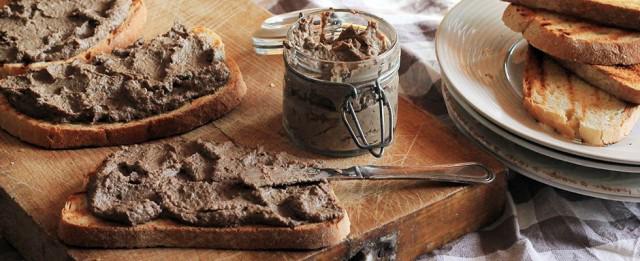
When in Tuscany, I always start with croutons with liver pâté, the Tuscan starter par excellence. There are so many variants, every Tuscan housewife has her own recipe, transmitted from generation to generation: some cook them only with chicken or rabbit livers, some use only the spleen, some prepare them with mixed meat.
In the past croutons were prepared twice or three times a month with hard bread. For this reason people dipped them in broth or in vin santo before eating them, and today someone still does it.
FIRST COURSES: SIMPLICITY AT ITS BEST
More than pasta, soups based on simple but tasty ingredients dominate Tuscan cuisine. Recipes are so basic that you could try them at home (sometimes I do it), but without "Tuscan" ingredients they will never taste the same. I am not a soup fan, but in Tuscany I always eat more soup than pasta, because Tuscan soups are so tasty!
La Pappa al Pomodoro
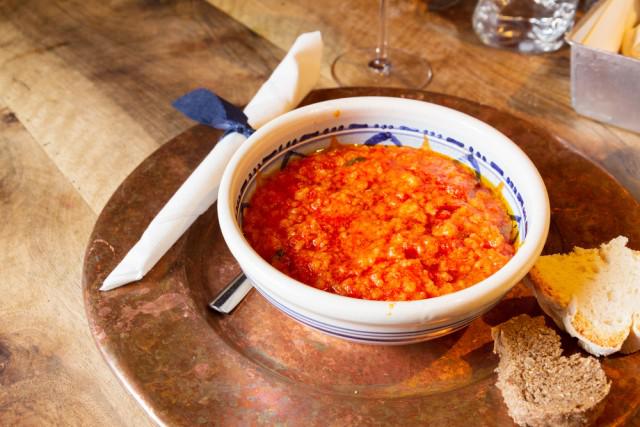
Bread and tomatoes are part of the DNA of a Tuscan.
The main ingredients of this great dish are tomatoes and "silly" bread, the poorest ingredients of the peasant tradition.
Bread is cut in thin slices and then baked for a few minutes. Then tomato and basil are added, so that the slices of bread are completely covered. After seasoning with salt and pepper, they add vegetable broth and cook on low heat for 40-50 minutes to evaporate the liquid, and stir occasionally to reduce the bread in the juice. Olive oil is added before serving, but you may add much more if you like.
Pappa al pomodoro is consumed predominantly in summer when tomatoes are ripe and pulpy, but you may find it all year around.
La Carabaccia
Carabaccia is also called "onion soup a la Florentine", and it has been the subject of several quarrels for centuries with the French version. They brown fine cut Tuscan red onions in olive oil along with a beat of carrots, lard and celery, then simmer with white wine until reduced, cover them with broth and cook for at least one hour. They may add almonds, and eventually break an egg on it at the end of cooking.
La Ribollita.
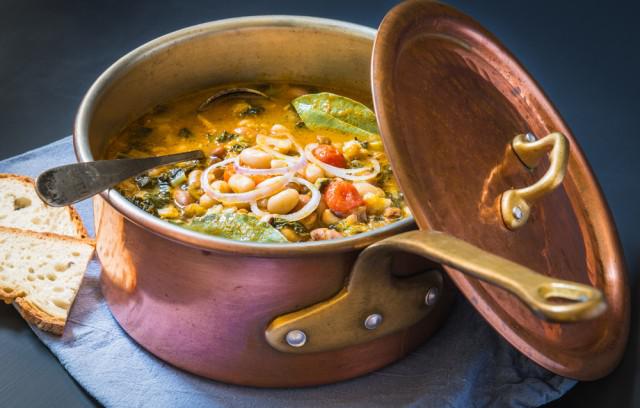
Ribollita is a well-known traditional soup that has become the symbol of Tuscany. It is a poor dish of peasant origin, basically a soup of vegetables and bread drenched with black cabbage and beans (only “borlotti” or “cannellini”).
Ribollita is a dish associated with winter, when vegetable gardens produce black cabbage leaves. You may add beets, some potatoes, carrots, celery and onions: every cook has its own recipe for the bread soup. The name comes from the preparation: a big quantity was cooked often on Friday, then in the following days it was boiled several times. It is better if you eat it “rested”, that is left at least one night before being boiled again. While resting, the soup absorbs all the aromas and gets more balanced; if you wish (I always do), you may add extra-virgin olive oil or season it with fresh onion.
L’Acquacotta
Acquacotta is a vegetable soup typical of the traditional cuisine of Lower Maremma (the southernmost part of Tuscany, bordering on Lazio). This dish comes from the tradition of the “Butteri”, the cowboys of the area: when they carried herds to pasture they had little space for food, so for their main meals they prepared a soup with the herbs found in the countryside, stale bread and onions they had with them. It's a simple dish, made with “easy” but very rich and nutritious ingredients.
The main ingredients are celery, onions and tomatoes (but also spinach, cabbage, broccoli, chicory or spontaneous herbs such as dandelion or nettle) to be cooked slowly in broth; once they are almost cooked, first eggs and then slices of Tuscan bread, possibly a few days old, are added.
I Pici
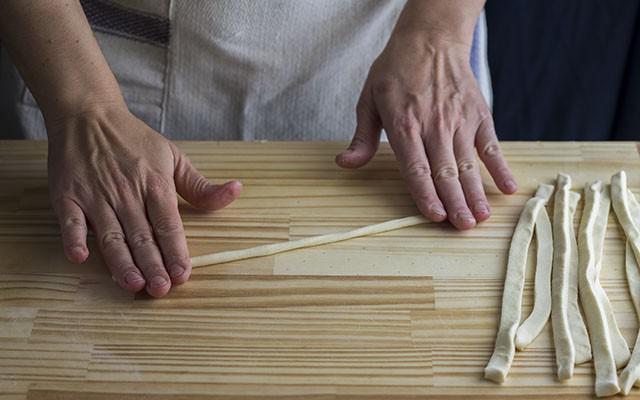
Pici is a very old kind of pasta dating back to Etruscan times (700 to 500 BC). The name of these thick handmade big spaghetti, of solid texture and irregular shape, comes from the characteristic action “appicciare”, that is “make thick ropes” that must be stretched rigorously by hand, one at a time; to keep them dry, you powder them with corn flour.
As to condiments, to dampen the pici and make them particularly tasty they use dense meat sauces like ragout and game (mainly hare, boar and duck), rabbit and pigeon sausage.
La Panzanella
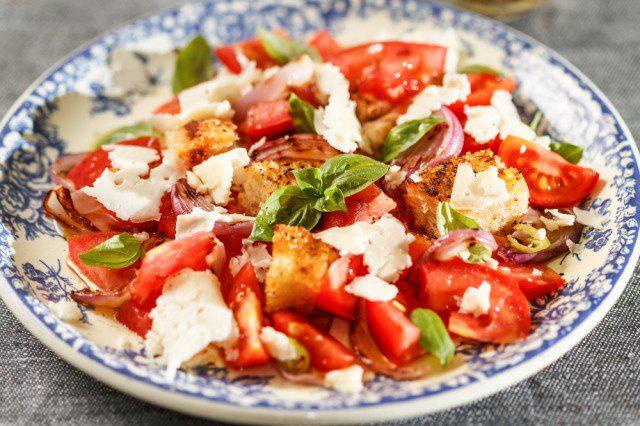
Panzanella is a home-made dish of humble, probably maritime origins. It was probably born aboard ships (where it is still in use today): they used to pour sea water onto stale bread and some vegetables.
This recipe can change from place to place if not from family to family. It is a combination of stale bread, red onion, basil, olive oil, vinegar and salt; you may add ingredients such as raw tomato, cucumber, olives, capers and anchovies, hard boiled eggs and tuna, rocket and other vegetables such as carrots, fennel, maize, celery and peppers. Every fantasy is allowed.
Il Sugo d’anatra.
Duck sauce, "nana" (dwarf in English) for the Tuscans, often accompanies homemade pappardelle or paccheri. In one of the most Tuscan traditional recipes you cook onion, celery and lard, adding the duck cut into small pieces (some cooks use only the chest). Once browned, the “nana” is simmered with a glass of Chianti until reduced, and flavored with rosemary and sage. Then you add a little tomato concentrate, dissolved in a ladle of hot water, and a pinch of salt and pepper, and slowly bake as if it were a meat sauce.
SECOND COURSES: TUSCANS ARE NOT VEGETARIANS
La Bistecca alla Fiorentina
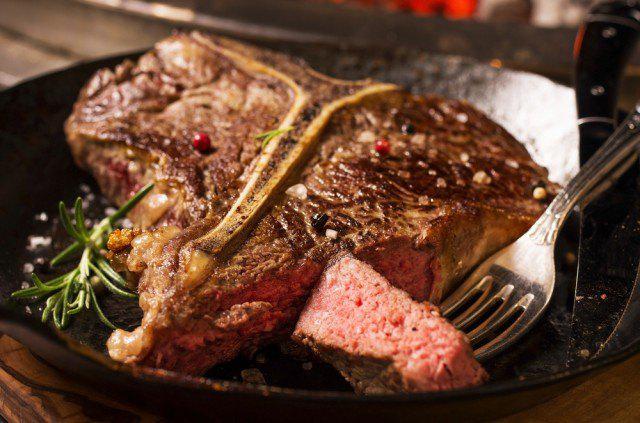
T-Bone Steak in Florence is called “Fiorentina”. It is the best piece of meat, the most noble part of the “bove”, the steer, never the calf: deliberately left with the handle, without detaching it from the rib, it must be at least three fingers thick, weigh at least one kilogram and include the fillet.
In theory the simplest dish to cook, and instead it requires great expertise. About meat, about maturation, about baking. Particularly maturation, which allows the meat to remain soft. Cooking must be fast and blood-free. Original Fiorentina is grilled with fire made from wood or charcoal; many restaurants also cook it on a cooking plate or on lava stone, with excellent results.
T-Bone steak is served all over the world, but when I am on tour in Tuscany I always take my travel mates to a restaurant where they cook Fiorentina: they usually have a hard time finishing it, but on the other hand they would keep on eating. Mmmmmm….. so juicy!
Il Lampredotto.
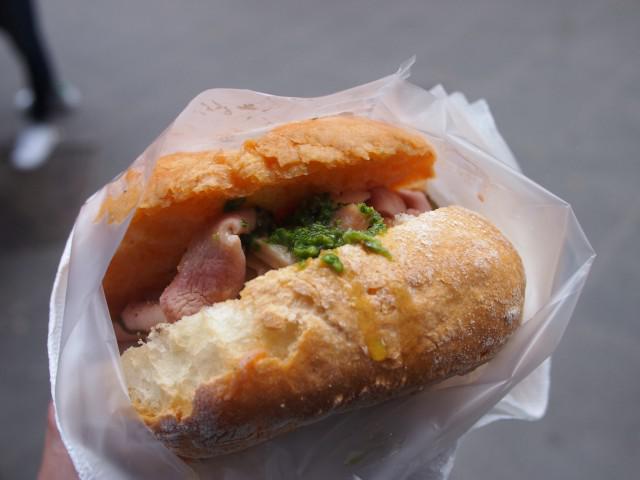
Lampredotto is a type of tripe, basically abomasum, one of the four stomachs of the cattle. The Florentine street food par excellence is served by the many “trippai”, or tripe cooks, in all parts of the city. Eat it in a sandwich, seasoned with salt and pepper, or if you prefer green sauce or spicy oil: if you are bold enough you may put both of them. You can eat it boiled with sauces or try fried lampredotto chops, lampredotto-stuffed ravioli with onions and, why not, lampredotto sushi: it will leave you speechless.
Il Peposo.
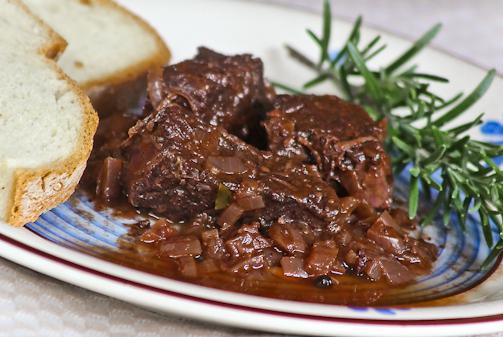
Peposo was created by the bakers of Impruneta, not too far from Florence, who used to bake it in the oven where bricks were also cooked. You take beef muscle, cut it into pieces and put it in a pan together with a few bulbs of unpeeled garlic, broken salt, pepper in grains and red wine. When eating Peposo you must “fare la scarpetta”, i.e. dip Tuscan bread into the sauce.
Il Baccalà alla Livornese
Codfish “alla Livornese”, or "of the four moors", is a sea dish that can only come from Livorno, the main port of Tuscany.
The fish should be kept desalinated under a stream of running water for at least a day. According to the traditional recipe, firts you make a soffritto with extra virgin olive oil, garlic, onion, parsley and basil. Then you add tomato, and afterwards you put the pieces of cod in the tomato sauce and let them bake with the wine. To complete the dish, add chopped garlic and parsley before serving.
La Trippa alla fiorentina.
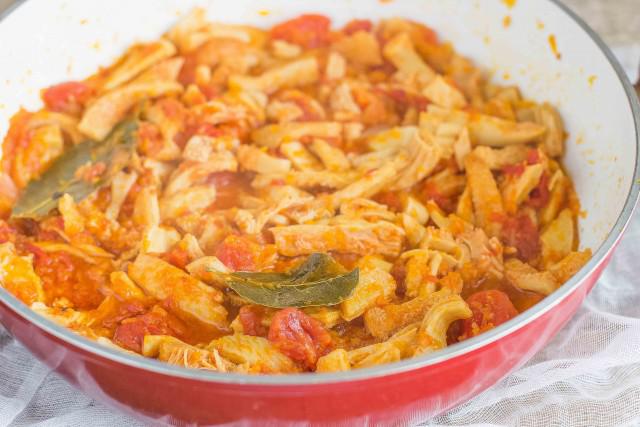
Once they said: "Thursday gnocchi, Friday fish and Saturday tripe". Tripe on Saturday because it was the day of the week when animals were traditionally slaughtered. The master always took the best meat cuts, while the offal went to the farmer. In Florence eating tripe is a must. The white tripe is well washed and boiled, then cut into strips, browned in olive oil with a celery, onion and carrot sauce, enriched with ripe tomatoes and seasoned with salt and pepper. Before serving, it is usually sprinkled with grated Parmesan cheese.
Il Cinghiale stufato
Going to Tuscany and not eating wild boar stew would be like visiting Florence and not walking on Ponte Vecchio. Marinating is extremely important: you should leave the pieces of boar meat to savor for at least a day in a marinade prepared with oil, onion, pepper, juniper berries, carrots, laurel, wine and vinegar. I love it!
Pollo alla cacciatora
Chicken “alla Cacciatora” is a second course typical of the Tuscan cuisine but popular in most regions of central and northern Italy. There are many variants of this preparation, some with tomatoes and others without. The ingredients to match the chicken are black olives, garlic, carrot, celery, anchovies, browned with extra virgin olive oil and garlic, with the addition of rosemary and laurel. Another variable is also the wine used to simmer the chicken until reduced: in central Italy they cook it with red wine while in the north they prefer white wine.
Cheese and cured meats
As to “salumi” and cheese, Tuscany is a land of excellence.
Cured meats range from "finocchiona", a large sausage flavored with fennel seeds, to “soppressata”, a galantine of head meat with tongue, spices and pistachio, then pork and wild boar hams, first of all “Cinta Sienese”, made with the meat of the typical black pig grown on the hills of Siena. How tasty!
Pecorino is “the” Tuscan cheese. The most valuable are the ones produced on “Le Crete” (crete hills) of Siena and Arezzo, where the flowers of absinthe blossom, giving the milk a particular aroma, and the "Marzolino" of the Chianti area.
Beans are also very popular as a side dish but also as a dish in their own. You can eat them boiled and seasoned, and also “all’uccelletto”, with sage and tomato sauce.
It’s not over yet……
Among the desserts of Tuscan cuisine, don’t miss “Castagnaccio” prepared with chestnut flour, “Panforte di Siena", rich in dried fruits and spices, "Ricciarelli" of Siena, based on marzipan, and finally "Cantucci" of Prato, scented dried biscuits of anise and enriched almonds that are soaked in Vin Santo, the “holy” liqueur wine of Tuscany.
Well, culture is not the only reason for visiting Tuscany, would you agree?
